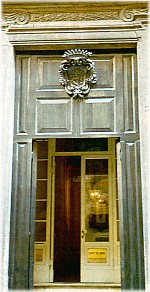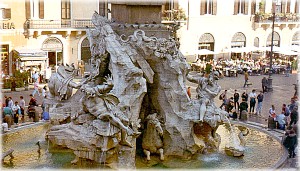| Centro Pro Unione - Piazza Navona The College of Innocent - "Collegio Innocenziano" |
The College of Innocent, whose name comes from Pope Innocent X Pamphilj, was constructed during his pontificate (1644-1655) for the purpose of preparing young boys born on the Pamphilj properties for the ecclesiastic life. The children arrived in Rome at the age of seven and lived in the college while continuing their studies at the Roman schools; their expenses were covered by the first born prince. Based on the Pamphilj patronage, the family could also choose the cardinal protector of the church as well as the rector and officiating clergy. According to tradition, the typical welfare institution seems to have been the wish of Olympia Maidalchini rather than that of Innocent X. She dedicated herself to the Pamphilj buildings from 1653 (the year she was re-admitted to the pontifical court following a period of disgrace) until 1656 when she was sent away from Rome by the wish of Alexander VII (Chigi). Built on the western side of the square, the building complex was part of a program of normalization of the site by the Pamphilj pope with the objective of transforming Piazza Navona into the family island. It was built on the area of the ancient Rivaldi palace bought from the Ornano family in 1653. In 1654 the old building was demolished to build the sacristy of St. Agnes in Agone and the College. Francesco Borromini, the architect, already worked for the Pamphilj's on the princely palace in Piazza Navona. |
 Entrance to "Collegio In-
nocenziano", present day Centro Pro Unione |
 View from 'Conference Hall' - Piazza Navona |
It occupies an area that goes between via dell'Anima and via di S. Agnese and looks onto piazza Navona with a facade whose serliana appears as the Borromini hallmark of the Pamphilj's.
The same three-mullioned window with central arced opening and two lateral trabeatas are also found in the building next to the facade of St. Agnes. The projection of the spiral ramp of access to the noble apartments and courtyard are due to Borromini. |
|
In the latter the lower steps support
lintels while the upper ones another serliana. On the noble floor,
is found the library whose ceiling were frescoed by Francesco Cozza:
with the three virtues (Generosity, Justice, Faith) on the vaulted
ceiling of the small antechamber we find the Triumph of the Pamphilj's
(1667). The artist was called to work in the College by Camillo
Pamphilj after he frescoed the Valmontone palace between 1657 and
1661.
The students didn't take up residence in the College before 1658. In this space don Camillo prepared a hall, two smaller rooms and a few corridors for his personal library together with the inherited one of the Pamphilj's. In his testament (1666) he made money available for the engagement of a librarian; he likewise recommended the transfer of the books conserved in the palace on Piazza Navona to the College. The care of the book patrimony was to be entrusted to Niccolò Angelo Caferri, a gentleman and literary person in Camillo's court. Taken from: L. Montalto, II Collegio Innocenziano, in Piazza Navona Isola dei Pamphilj, Roma 1970, pp. 241-246
|
|
« « ¦ Back to "Centro Pro Unione - Piazza Navona" |